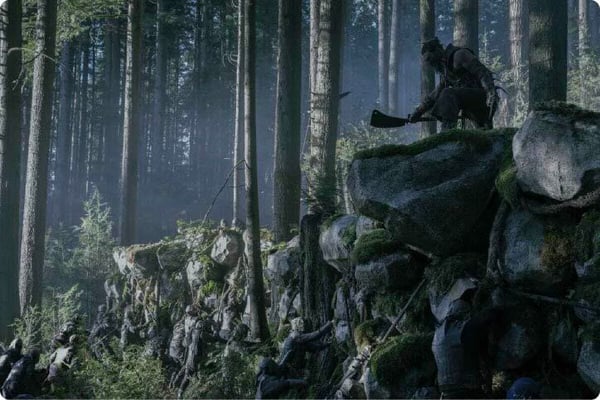We interviewed Jeremy Peirson, a Supervising Sound Editor, Sound Designer, and Re-recording Mixer for the Apple+ show See. Peirson has dozens of credits on different projects and he has also been a Sound Particles user for quite some time. We were fortune to have him sit down with us for this interview and talk about all things related to audio work and Sound Particles.
I saw that your first gig included being involved in the post-production for Matrix. How did you get that gig?
.jpg?width=181&name=Artboard%202%20(1).jpg)
Once I finished College I moved out to Los Angeles and naively thought that I would take my resume around town and get in somewhere. One day after dropping off a resume at TODD AO, I was at a red light and saw this company called Danetracks. I went home, looked it up and it was a post facility. I called the next day and they said they were looking for interns. I met with them and it went well enough that I started the next day as an intern on the Matrix. It was all literally happenstance: the car was at the right place, I just happened to look over and it all kind of worked out.
What was it like to witness the creation of the sound of Matrix?
It was quite an experience because I got to see pretty much every phase of the movie making process. I came in right after the first temp mix, which is right after the director’s cut. I was there when the producer saw it for the first time, what it looked like before all the visual effects had come in, I got to see how the editing and the sound design were done and how much recording went into that process. It was a real eye-opening experience and it set the tone for me and how I was going to approach working on movies in the future because of all the work that Dane [Dane A. Davis] had laid in his approach. It was interesting to sit in there, with Dane, as he was designing the sound for the movie and to learn when I can ask questions and get his insight on his approach. I was there for a while, so I got to see the thinking behind what it is we need to do as Sound Editors and Designers, so it was a pretty unique situation to be in.
How did your career evolve from there?
Luckily, due to the work I put in with Dane, I was able to get a position at his company. I had figured out a way to hook up a variety of Pro Tools machines and run cables so that we could mix using three or four systems, which in 1999 was not common. It was really interesting to have all these things hooked up, then do the mix and that led to working on different movies there. Then, I had the opportunity to be a mix tech at Warner Brothers with Mark Smith and Ron Bartlett, who I had worked with before. To me this became the natural evolution to become a mixer: you first are the recordist, then the mix tech and that’s the pathway. But the industry was changing, and they weren’t really interested in training mixers, so the recordist path I had idealized was sort of a dead end. Coincidently, I had to leave that job due to a bunch of writer strikes and got an offer to do some editing with Skip Lievsay. Fortunately, it all worked out from there and we have been working together since 2001. As you can see, it’s all about relationships and following the path, as long as you have the work to back it up.
Do you think there used to be more time to learn back then?
I certainly do. To me as an audio editor, I learned more about editing by being on the mixing stage with the mixers who are mixing the material and trying to figure out the mechanics of what’s required from editing. However, given the way that things are working right now, it’s hard for editors to sit on the stage and really learn that stuff. Back then, crews would have up to 14 editors, whereas now crews have 5 or 6 at the most. So, it meant that you had 14 people that you could get information from but now if there’s one sound effects editor, he/she doesn’t have the time to explain the approach, because all responsibility is on that person’s shoulders. On top of that you have the security policies with all the NDA’s that we have to sign, not allowing us to talk about what we’re doing. Thus, as you can imagine, all of this makes it a challenge to teach less experienced professionals. Some of us have been trying to figure out ways to change that, because we need to bring people up and to show them the way. When I started mixing, there were people who would share all the knowledge they had, and others didn’t want to show anything. I even remember a mixer telling me that all of us sound editor and mixer types were ruining the industry and I said “Well, you guys never taught us so you’re concerned that the craft is being lessened right now but you never took the opportunity to train anyone. You haven’t passed down the torch”. So I think that now it is even more important to figure out ways to educate people.
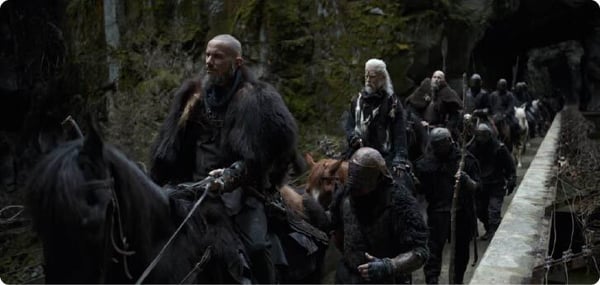
In your opinion what are the biggest differences between working in a film and a TV series?
The biggest difference is time. With TV you got one shot at it, you feel the clock every time you’re editing or mixing. Whereas on a film you can try something, let it sit for a couple of days and then can come back to it to refine it. Having worked on See I have a newfound respect for the people who work in TV because it’s hard. The standards and expectations are still the same but the time they’re given to do it is not the same at all.
In film you get to live and breathe with it for a while and I don’t know if you always have that opportunity in TV. My crew and I are film people, so in terms of how we approached See our bar is set to a film bar. Also, because See was made with Francis Lawrence, with whom I work all the time, I wanted to give him that experience. We’re happy with what we did on the show, but it was hard in terms of the timeline. That’s where experience comes in and knowing how to get from A to B efficiently is key.
You usually have more than one role on a project, what are the advantages and disadvantages of doing so?
I prefer to be able to supervise and mix the show at the same time because as I’m cutting, I’m able to see where I’m going to be able to get to, and I may lay a path work for that kind of mixing. It also allows me the ability to have an inside scope of what the intentions are in the show, as opposed of just being the mixer, where the material shows up and you have no idea of what’s been talked about before.
On the flip side, it makes it harder because as I’m mixing, I’m also thinking “Is reel 2 ready and conformed?”, “Are they working on it?”, “How are they doing?”. Basically I’m trying to make sure all the balls that need to be working are in play, so that we can continue mixing efficiently. Therefore, I feel very occupied and when I leave at the end of the day I’m still thinking about the job. Whereas as a mixer your responsibility sort of ends at the end of the day. Of course, you’re still thinking about what you’re going to do and how you are going to achieve it, but it’s not the same level of responsibility.
For shows I supervise and mix I’ll move into the picture department. That allows me to have the director to come in and look at whatever is in progress. There are times where having a director come in and see what I’m working on gives him a picture idea. Then he/she goes back to the picture editor to make a change and they give it to me. I work on some sound, I give it back to them, they make another change, and this creates a symbiotic relationship: picture and sound are really all working together, it’s an interesting process.
You’re the Sound Designer, Re-Recording Mixer and Supervising Sound Editor for the show See. In a show which depicts a world where people are blind, how did you use sound to complement the story/to tell the story?
I would say the biggest aspect is that everything needs to have a sound cue. Take the battles for instance: any time they’re fighting there has to be a motivation for why Jason Mamoa attacks somebody on the right or left, there has to be a reason why that happens. So, we had to find the little piece and figure out what’s going to work throughout the music and develop these sort of sound cues. The other part of that is that there’s always stuff happening, there’s always people touching things and making certain sounds they can echolocate, such as banging on trees with sticks as they’re quietly walking through marking where trees are, or people with whips trying to explore the way in front. And because everybody is always touching something or making sounds with something, there’s a lot of detail and foley that we had to add. It’s all about the details, a lot of specific why’s: “Why is that sound being made?”, “Why is that action happening? We need something for that.”, and also understanding when and why certain people would be making sounds. In a battle, for instance, there’s essentially two groups attacking each other and instead of everybody yelling and charging, we had to fight that impulse because they wouldn’t be yelling, because if they were yelling, they could hear where they were going and that would give away their locations. All of this created a new and very important thought process that made us reflect about what you hear, how you hear and when you hear it.
Additionally, because everyone is blind there was a definite direction of making it as lush and interesting as possible. Fortunately, we had the advantage of being on a non-technological based world, where they’re out in the woods all the time. So, we took the opportunity to make it sound as real and distinct as possible, so instead of having a couple of background tracks, or a couple of birds, we created the backgrounds with a lot of detail and a lot of things going that normally we don’t include but this world allowed us to.
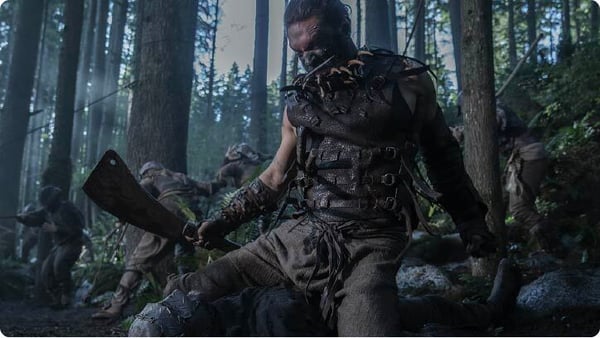
What is your favourite sound effect from this specific project? How did you manage to create it?
I would say that there are two. One was not created; it was recorded, and it’s the most amazing thing I’ve ever recorded. Knowing that the show would be set in the woods, I went to record forest sounds in a way that I hadn’t heard before. I put together a rig and spent four days in central California recording forests in what I would call a wide 7.0 format. In some of the multichannel recordings that I’ve heard of forests everything felt too close, because the mic arrays used were simply too close. So, I decided to put together a mic pattern that was 50 feet across and about 100 feet deep in a 7.0 sort of configuration with all microphones pointing out. That created a depth and a surround ambient level, that was completely real to me.
One microphone would be picking up a squirrel in that particular tree, while another has got a bird over there and they’re all discrete, while keeping a cohesive feel to them. And I remember there was a bird that started chirping as it was flying, and so you have that ‘right surround to front’ aspect of this bird going by, squawking, and as it goes through the trees, you’re there! It’s the real deal! And to me, I listen to that and I’m like “wow” I don’t know that you can ever recreate that easily, because of the way it interacted with all the other trees and I loved that!
The other sound was made from a bunch of bullroarers I created and recorded. I went out to the Angeles forest, which is near us, and recorded that for one of the episodes where the bad guys are trying to intimidate our main characters. A bullroarer is a weighted piece of wood caught up on a string that as you spin the string, the wood twirls creating very interesting and unique sound. I had found a wire brush that added this metallic flavour to it, and there’s a particular shot where you see the guy 10 feet away and he’s got a 20 foot rope that he’s spinning this thing on and in Dolby Atmos you can fully experience it travelling by, and going over your head. To me these were unique and pretty cool sounds that I was particularly proud of.
How different is the experience with Dolby Atmos to depict the complexity of deciphering the world without vision?
I think because of the combination of the editing and the mixing that we did, knowing that it would be in Atmos, allowed for a lot more depth and detail than you would normally get. For instance, when a certain scene is set in the forest, I usually have two to three pairs of foliage movements in the ceiling speakers, so that as we are surrounded by the forest, we always get the sensation of what would be above us, and by slowly moving that it adds another layer of depth and makes it more interesting.
Another curious aspect is that we mixed everything in Atmos and then we rendered out to 5.1 and when we listened to that and we thought “Wow this sounds really amazing, it sounds wider than the 5.1 would normally sound”. And then, we listened to the two tracks, and the sound had a dimension to it that I can’t quite place. I went back and I listened to some of the initial 5.1 mixes that I had given to the picture department and compared it to what we ended up with and it sound much wider. And even though the 5.1 or the two tracks will never be what Atmos sounded like, at least you’re giving all that creative energy, letting the spirit of that live in that track all the way through the whole process. I think in that respect using Atmos in every possible way is the way to go. I’m now working on it from the very beginning of the show. I have an Atmos set up that I use and I’m going through the Dolby box and listening to it in 7.1 or 5.1 the entire way through, and that affects my approach in terms of how I’m going to cut, how I’m going to want stuff mixed or what kind of creative opportunities we can have.
How did you use Sound Particles in See?
I used it in a very realistic way with the human voice. We had a scene where one of our main characters sings and there’s a call and response from the group that’s watching her chanting. The production sound was recorded with a VR mic’ to add a wider feel, however this also enhanced other on-set noise. The scene contained dripping water and it felt like water was everywhere once we expanded it out to 7.1.
On top of that, they changed the song in ADR, so now the crowd had to sing something different and we didn’t have that crowd anymore. And then, in visual effects they added about a thousand more people. To try to solve this, we went on the stage with a group of 10 actors and recorded 10 passes of the new chant. When we went to the mixing stage and reviewed the recording the mixer said “I don’t have what I see on the screen. Let me try some stuff with layers, EQs and choruses” and we realized “That’s not it” and I said “I have an idea! Let me go to my office for a little bit, let me get this track and let me spend a little time”.
I took those tracks and I threw them into Sound Particles, using an emitter with around 500 particles. I started by playing with the emitter’s depth to mimic how close everyone was and figuring out the mic position that I wanted. After figuring out the maximum distance the particles could be in the x and y axis, I added slight timing and pitch variances using the random audio modifiers. Figuring out what still sounded real, what pitch to use and with how many particles I could get away with, and make it time aligned and not all sounding like it’s all the same thing. Eventually we came up with the answer and it was like “Oh! There it is!”. That happened a couple of times.
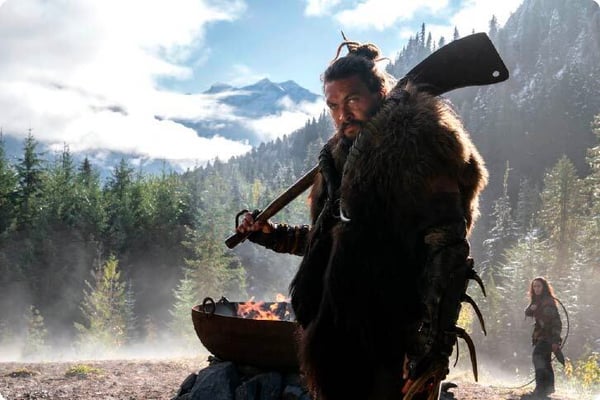
We had another situation where we wanted to hear an entire village start chanting the name of a certain character and there was no production crowd for that. We similarly had 10 actors do 10 passes and we were able to make 10 people sound like 400 or more at distance. The first crowd was done in 7.1 because there were times that we were in the crowd, the other one was off in the distance, so I did more like a LCR approach from Sound Particles, that proved invaluable. It was the only way I could figure out how to do it.
For me, the way I use Sound Particles and why I use it is because I can’t figure out a way to realistically create sound for a scene otherwise, now that I know what it can do there’s only one solution. It’s just a matter of trial and error where I figure out what’s too much and what’s not enough, what’s too close and what’s not close enough. The flexibility Sound Particles provides make it work.
Due to current circumstances, it is not possible to get groups of people together to record crowds or groups singing like you did in See. Do you think Sound Particles could be a way of overcoming this by combining separate recordings within SP?
It’s funny because I hadn’t really thought about using Sound Particles for group crowd type situations. In a way it makes sense because a few of my peers were all talking about how we are going to record group. I have friends who are actively trying to figure out how they are going to do this right now. However, there’s a new problem which is recording all these individual actors.
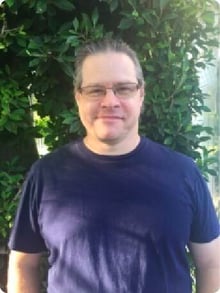
There’s been some discussion about recording some of the stuff on a very large Zoom call with up to 20 actors, so that everyone can communicate and hear what everyone else is doing, but everyone is recording independently at their place.
This creates another problem, instead of having 20 people all together in a stereo file, you have 20 recordings at various levels, with various recording and acoustics properties. They all may need fixing individually and you need to figure out how to make it all work from 20 individual tracks, instead of a natural composite of two, and you might have many of those situations. If you can get the audio recorded and cleaned up, then put it into Sound Particles, space it out with randomized placements and slightly randomized timing and pitches, it would be possible to do it! I didn’t think of that, but it makes a lot of sense. I’m actually going to suggest that to a friend of mine.
It’s great to hear how professionals like yourself use the software. There are so many possibilities with Sound Particles, it’s good to hear how individuals are using it in different ways.
It’s an interesting audio tool, over the years I’ve used it in situations where I don’t know how I’m going to create or enhance a certain sound, I’ll start by making particles and throwing sounds in and experimenting. Fortunately, certain aspects of how the software works will trigger an idea, one approach will inform another, or trying to find a solution in a certain way creates a happy accident I hadn’t thought of. Thank you for making such a cool product!
Topics: Sound Particles, Audio Software, Sound Design, Interviews, Sound for Film and TV, 3D audio, Surround Sound
